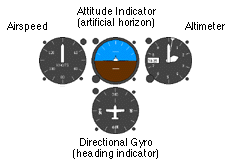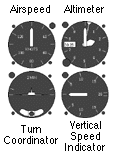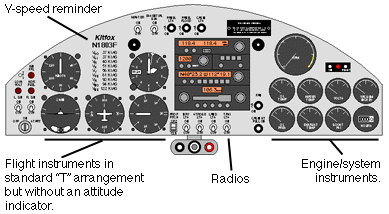
| Home | On-line Catalog | Tips from the Experts | Wanted/For Sale | Downloads |

| Home | On-line Catalog | Tips from the Experts | Wanted/For Sale | Downloads |

Something I've noticed over the years, and seems stranger and stranger to me as time goes on, is that a lot of homebuilts have panels that look like the builder stood back and threw a handful of instruments at the panel, installing each one where it hit.
Back in the "olden days," even factory-built airplanes had panels that were designed that way, but for decades now the FAA has required certified airplanes to have certain things in certain places. Without getting into the nitty-gritty human factors of the rule, it makes sense in a simple way: most people fly more than one airplane throughout the life of their pilot's license, and it's easier to move from one to another if everything is in the same place. For instrument rated pilots, the need for standardization is even greater, since they rely much more heavily on the instruments for basic aircraft control. In the course of learning to "fly the gauges," your brain becomes quite adept at finding information in the same place each time it is needed. The organization required by the FAA is known as the "Basic T" arrangement.

The Basic T arrangement calls for the attitude indicator to take center stage in front of the pilot, flanked by the airspeed indicator on the left and the altimeter on the right. The directional gyro is located below the attitude indicator. The two additional instruments found in most factory-built airplanes are the turn coordinator and the vertical speed indicator, located to the left and right of the directional gyro, respectively.
Variations on the T arrangement often make sense for light airplanes, though. What if your plane doesn't have an attitude indicator or directional gyro? Or perhaps you don't have any gyro instruments. Maintaining the arrangement of the remaining instruments still makes sense. Removing the gyro instruments from the center leaves your brain looking in the right direction for the right instrument.

Even factory-built planes with panels using the basic T are far from perfect. If you sit in any of the many flavors of Piper Cherokees with a chart clipped on the yoke, you'll soon discover how difficult it is to see the engine instruments, particularly if the plane is equipped with a constant speed prop and there are two power instruments to monitor. Pick your favorite single engine Cessna, take a scenic night flight around town, and notice how the overhead panel flood light is blocked by your head any time you lean forward to look for traffic.
Obviously, a good panel design (and good lighting design, if the plane will fly at night) involves more than just proper instrument arrangement. An excellent idea suggested by Richard DeWitt, technical counselor for EAA Chapter 538, is to mock up the panel design and test it in a dark hangar or garage using the lighting system arranged as it will be in the plane. Move around and adjust the intensity to make sure you have the light you need where you need it. If you can't read the instruments in the hangar, it's time for a re-design.
If the T arrangement is so great, then why the splatter method of panel design? In some cases, the design of the instrument panel or its support structures may preclude the placement of some instruments in the desired location. Many single place homebuilts have panels so small, the builder has no choice and must place the instruments where they fit. Sometimes a builder may think that their own arrangement makes more sense than the standard arrangement. Once in a while, no designing went into the operation at all.
Often, as pilots, we climb into a new airplane and attribute some of the initial confusion or extra instrument hunting time to unfamiliarity with the airplane. This is true, but having a scrambled instrument arrangement is a sure way to cause confusion. Experience in a plane with a strange panel allows the pilot to develop proficiency with its quirks, but moving to or from another plane will almost always reduce cockpit efficiency.
How many of you can sit in your airplane, with your eyes closed, and locate the important controls and switches by touch? Electrical failures at night do happen--could you land the plane by touch if you had to? The next time you have a fellow pilot or flight instructor out to see your plane, have them suggest switches, controls, or instruments, and practice finding them with your eyes closed.

This layout for a Kitfox panel is very similar to that found in many Cessnas and Pipers.
Phone 602-978-0553
Fax 602-547-1468
 |